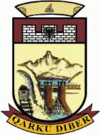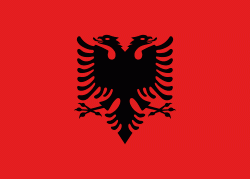Dibër County (Qarku i Dibrës)
 |
Topographically, the county is dominated by mountainous and high terrain, with a great variety of natural features including valleys, canyons, gorges, rivers, glacial lakes and dense forests. Various mountains ranging between 1500 and 2700 m meters above sea level run the length of the county from north to south, including the Korab mountains in the east with Mali i Gramës and Korab at an altitude of 2764 m being the highest mountain in the county and as well as in Albania. The Dejë mountain 2245 m rises in the center, while in the east the county is dominatet by the Lura mountains. The Skanderbeg mountains on the west separates the Central Mountain Range with the Western Lowlands. The county, marked by a significant biological diversity, is water-rich with a dense river network, a rich aquifer system, and significant karst underground watercourses. It is home to the source of the river Mat which rises in Martanesh. Besides the Mat, the Drin river is an important waterway in the region.
The county territory covers four distinct climatic types as of the Köppen climate classification; oceanic, continental, mediterranean and subarctic. Located in the interior of Albania, the climate is mediterranean with continental influences. Mean monthly temperature ranges between -20 °C (in January) and 25-30 °C (in July). Mean annual precipitation ranges between 600 mm and 1000 mm depending on geographic region and prevailing climate type.
Dibër is an historically homogeneous county. Its capital and most populous city is Peshkopi. Tourism is one of the most important sectors in the county and has the largest potential to be a source for sustainable income, due to its natural and cultural heritage. Although the county has abundant natural resources like chromium, sulfur and marble. Dibër is predominantly an agriculture county.
Human activity in the territory of the modern Dibër County can be traced back to the Neolithic.
The region that today corresponds to the county territory was inhabited by the ancient Illyrian tribe of Penestae. They were the first people to leave lasting traces and cultural heritage throughout the region. It is evidenced by the settlements of the Early Bronze Age in Manasdren, the Middle Bronze Age in Çetush, the Late Bronze Age in Pesjakë and several others.
In the Middle Ages, Dibër was part of the Principality of Kastrioti ruled by the royal Kastrioti family with Gjon Kastrioti on the Albanian throne. After the death of Gjon Kastrioti in 1437, the eastern region was annexed by the Ottomans and became seat of the Sanjak of Dibra. The comprising regions were awarded to his son Gjergj Kastriot Skanderbeg, where he survived to conquer back his father’s land and unite all of Albania in 1444. In the 15th century, further during the Albanian wars the region was the frontier between the Ottomans and the League of Lezhë.
In the 19th century, the Congress of Dibër declared the Albanian language as an official language within the Ottoman Empire. After the Balkan Wars and following the collapse of the Ottoman Empire, the great powers established the borders of the Balkan states at the Conference of London. The Dibër Valley was cut in half. The western part was assigned to Albania, while the eastern part went to the Kingdom of Serbia, today North Macedonia.
Map - Dibër County (Qarku i Dibrës)
Map
Country - Albania
 |
 |
| Flag of Albania | |
Albania has been inhabited by different civilisations over time, such as the Illyrians, Thracians, Ancient Greeks, Romans, Byzantines, Venetians, and Ottomans. The Albanians established the autonomous Principality of Arbër in the 12th century. The Kingdom of Albania and Principality of Albania formed between the 13th and 14th centuries. Prior to the Ottoman conquest of Albania in the 15th century, the Albanian resistance to Ottoman expansion into Europe led by Skanderbeg won them acclaim over most of Europe. Albania remained under Ottoman rule for nearly five centuries, during which many Albanians (known as Arnauts) attained high-ranking offices in the empire, especially in the Southern Balkans and Egypt. Between the 18th and 19th centuries, cultural developments, widely attributed to Albanians having gathered both spiritual and intellectual strength, conclusively led to the Albanian Renaissance. After the defeat of the Ottomans in the Balkan Wars, the modern nation state of Albania declared independence in 1912. In the 20th century, the Kingdom of Albania was invaded by Italy, which formed Greater Albania before becoming a protectorate of Nazi Germany. Enver Hoxha formed the People's Socialist Republic of Albania after World War II, modeled under the terms of Hoxhaism. The Revolutions of 1991 concluded the fall of communism in Albania and eventually the establishment of the current Republic of Albania.
Currency / Language
| ISO | Currency | Symbol | Significant figures |
|---|---|---|---|
| ALL | Albanian lek | L | 2 |
| ISO | Language |
|---|---|
| SQ | Albanian language |
| EL | Greek language |















